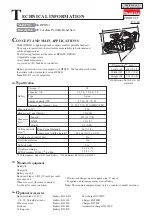
M
A
IN
T
E
N
A
N
C
E
/
R
E
P
A
IR
T
R
O
U
B
L
E
S
H
O
O
T
IN
G
O
P
E
R
A
T
IO
N
A
S
S
E
M
B
L
Y
/
I
N
S
T
A
L
L
A
T
IO
N
S
A
F
E
T
Y
/
S
P
E
C
IF
IC
A
T
IO
N
S
G
E
T
T
IN
G
S
T
A
R
T
E
D
12
TROUBLESHOOTING GUIDE
Symptom
Possible Cause(s)
Corrective Action
Teeth breaking
Coolant flow problem
Ensure proper coolant flow; hoses unclogged; nozzles pointed
correctly, etc. Make sure coolant type is suitable for the saw.
Material too hard
Check the blade speed and the type of blade you are using.
Also be aware of feed pressure.
Blade not worn-in correctly
With a new blade it is necessary to start cutting at half feeding
speed. After the wearing-in period (a cutting surface of about
300 cm
2
for hard materials and about 1000 cm
2
for soft
materials) the blade and feed speeds can be raised to normal
values.
Blade with excessively fine tooth pitch
The swarf wedges into the bottom of the teeth causing
excessive pressure on the teeth themselves. Use a blade with
coarser tooth pitch.
New blade inserted in a partially
completed cut
The surface of the cut may have undergone work hardening.
When starting work again, use a lower blade speed and
reduced feed pressure. A tooth from the old blade may be left
in the cut: check and remove before starting work again.
Work piece not clamped firmly in place
Any movement of the work piece during cutting can cause
broken teeth: check the vise, jaws and clamping pressure.
Rapid tooth wear
Feed speed too slow
The blade runs over the material without removing it: increase
feed speed.
Blade speed too high
The teeth slide over the material without cutting it: reduce the
blade speed.
Insufficient coolant
Check the coolant level and clean coolant lines and nozzles.
Incorrect fluid concentration
Check and use the correct concentration.
Material defective
The materials may present altered zones either on the
surface, such as oxides or sand, or in section, such as under-
cooled inclusions. These zones, which are much harder than
the blade, cause the teeth to break. Discard or clean these
materials.
Broken blade
Blade speed too high
Reduce blade speed.
Teeth in contact with material before
starting the cut
Always check the position of the blade before starting a new
job.
Insufficient coolant
Check the coolant level and clean coolant lines and nozzles.
Cuts not straight
Feed speed too high
Reduce feed speed.
Blade not perpendicular to workpiece.
Adjust blade tracking according to instructions. If this proves
unsuccessful, contact Palmgren technical support.
Green pilot lamp not
lit when ON button
pressed
No incoming power
Check connections at machine and power source.
Lamp fuse or bulb is out
Replace fuse/bulb.










































